- Home
- Quizzes
- My Quiz Activity
- Newsletters
- Sports Betting
- MY FAVORITES
- Add Sports/Teams
- SPORTS
-
NFL
- NFL Home
- Arizona Cardinals
- Atlanta Falcons
- Baltimore Ravens
- Buffalo Bills
- Carolina Panthers
- Chicago Bears
- Cincinnati Bengals
- Cleveland Browns
- Dallas Cowboys
- Denver Broncos
- Detroit Lions
- Green Bay Packers
- Houston Texans
- Indianapolis Colts
- Jacksonville Jaguars
- Kansas City Chiefs
- Las Vegas Raiders
- Los Angeles Chargers
- Los Angeles Rams
- Miami Dolphins
- Minnesota Vikings
- New England Patriots
- New Orleans Saints
- New York Jets
- New York Giants
- Philadelphia Eagles
- Pittsburgh Steelers
- San Francisco 49ers
- Seattle Seahawks
- Tampa Bay Buccaneers
- Tennessee Titans
- Washington Commanders
-
MLB
- MLB Home
- Arizona Diamondbacks
- Atlanta Braves
- Baltimore Orioles
- Boston Red Sox
- Chicago White Sox
- Chicago Cubs
- Cincinnati Reds
- Cleveland Guardians
- Colorado Rockies
- Detroit Tigers
- Houston Astros
- Kansas City Royals
- Los Angeles Angels
- Los Angeles Dodgers
- Miami Marlins
- Milwaukee Brewers
- Minnesota Twins
- New York Yankees
- New York Mets
- Oakland Athletics
- Philadelphia Phillies
- Pittsburgh Pirates
- San Diego Padres
- San Francisco Giants
- Seattle Mariners
- St. Louis Cardinals
- Tampa Bay Rays
- Texas Rangers
- Toronto Blue Jays
- Washington Nationals
-
NBA
- NBA Home
- Atlanta Hawks
- Boston Celtics
- Brooklyn Nets
- Charlotte Hornets
- Chicago Bulls
- Cleveland Cavaliers
- Dallas Mavericks
- Denver Nuggets
- Detroit Pistons
- Golden State Warriors
- Houston Rockets
- Indiana Pacers
- Los Angeles Clippers
- Los Angeles Lakers
- Memphis Grizzlies
- Miami Heat
- Milwaukee Bucks
- Minnesota Timberwolves
- New Orleans Pelicans
- New York Knicks
- Oklahoma City Thunder
- Orlando Magic
- Philadelphia 76ers
- Phoenix Suns
- Portland Trail Blazers
- Sacramento Kings
- San Antonio Spurs
- Toronto Raptors
- Utah Jazz
- Washington Wizards
-
NHL
- NHL Home
- Anaheim Ducks
- Arizona Coyotes
- Boston Bruins
- Buffalo Sabres
- Calgary Flames
- Carolina Hurricanes
- Chicago Blackhawks
- Colorado Avalanche
- Columbus Blue Jackets
- Dallas Stars
- Detroit Red Wings
- Edmonton Oilers
- Florida Panthers
- Los Angeles Kings
- Minnesota Wild
- Montreal Canadiens
- Nashville Predators
- New Jersey Devils
- New York Islanders
- New York Rangers
- Ottawa Senators
- Philadelphia Flyers
- Pittsburgh Penguins
- San Jose Sharks
- Seattle Kraken
- St. Louis Blues
- Tampa Bay Lightning
- Toronto Maple Leafs
- Vancouver Canucks
- Vegas Golden Knights
- Washington Capitals
- Winnipeg Jets
- NCAAF
- NCAAM
- Boxing
- Entertainment
- Lifestyle
- Golf
- MMA
- Soccer
- Tennis
- Wrestling
- More Sports
- RESOURCES
- My Account
- YB on Facebook
- YB on Twitter
- YB on Flipboard
- Contact Us
- Privacy Policy
- Terms of Service
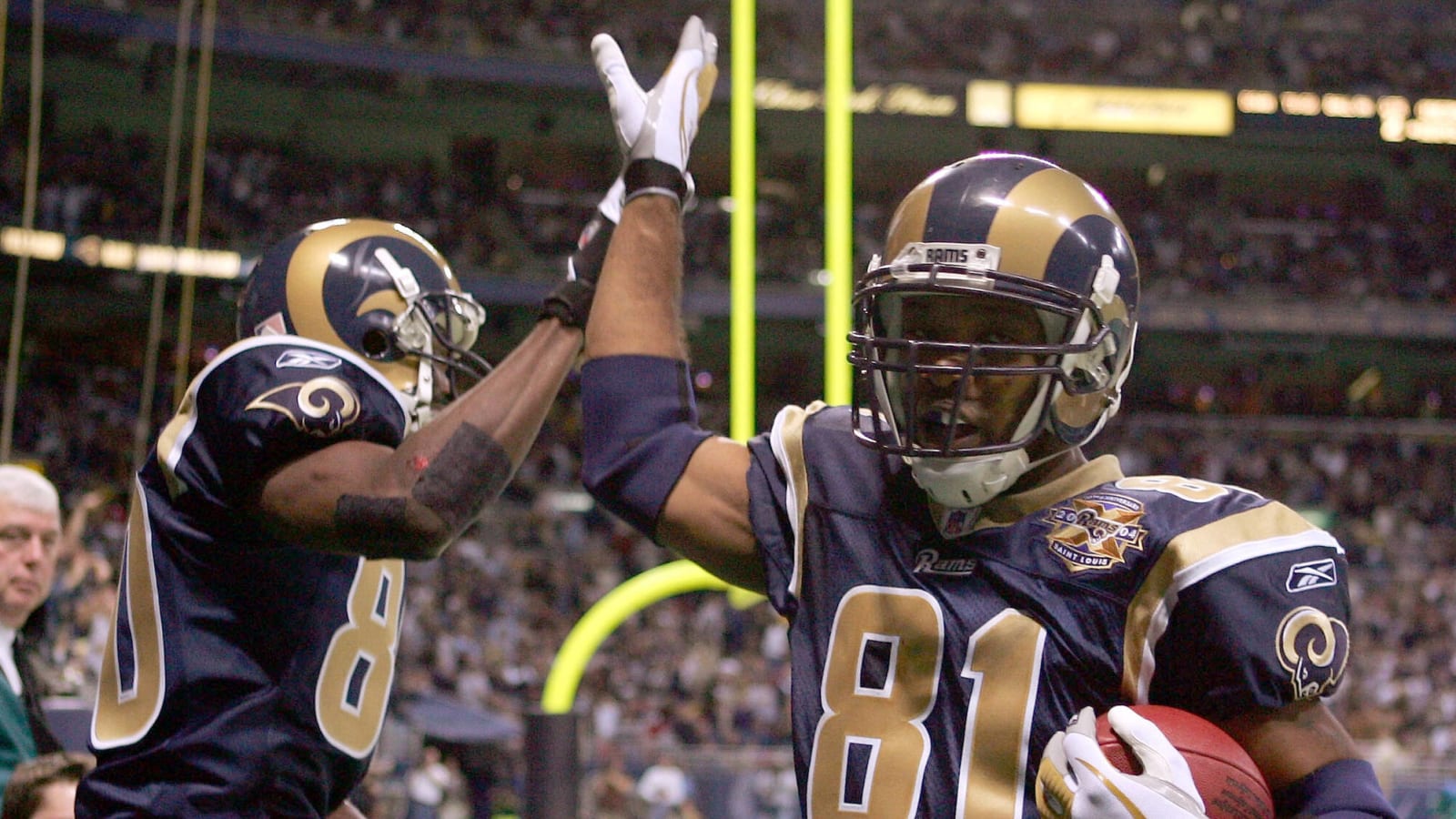
Ranking the NFL's all-time best skill-position groups
Consolidations of wideouts, tight ends and running backs have made important contributions for most of the NFL's history. Storied weaponry arrays have powered Super Bowl champions or become memorable even without a title. Here are the best skill-position groups in NFL history.
25. Tampa Bay Buccaneers: Brady mercenaries sign up
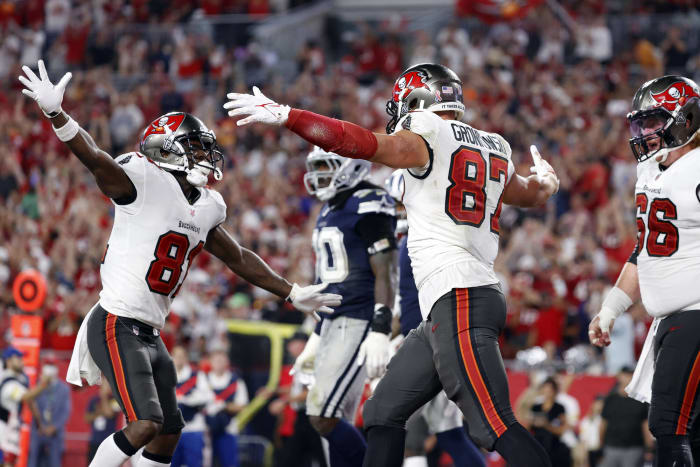
Bordering on a bonus inclusion, these Buccaneers are too talented to leave out. Rob Gronkowski and Antonio Brown were the 2010s' two most-dominant pass catchers. Both were past their primes by the time they joined Tom Brady's all-star gala in Tampa, but each made important contributions to the team's Super Bowl LV run and to Brady's All-Pro season a year later. They flanked lead wideouts Mike Evans and Chris Godwin. This is probably going to be a three-Hall of Famer collection, with Evans continuing a Canton case, and Leonard Fournette earned his "Playoff Lenny" alias in 2020. But Brown's 2020 suspension and predictable 2021 implosion limited this group's runtime.
24. San Francisco 49ers: CMC checks final box
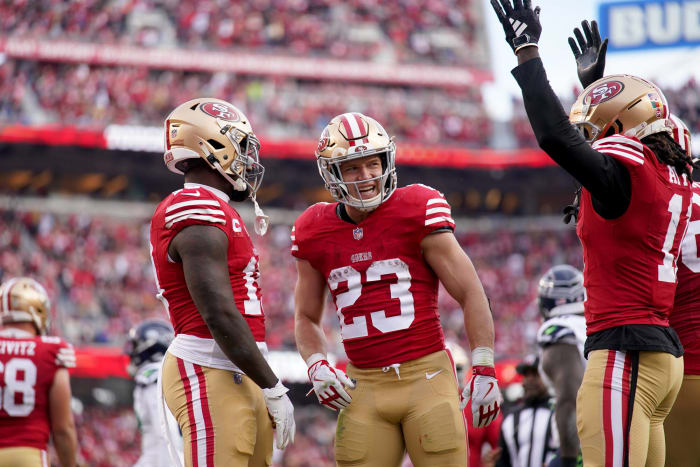
It is no longer premature here. Brandon Aiyuk topped 1,300 receiving yards in 2023, en route to second-team All-Pro status. He teams with three first-team All-Pros, with George Kittle and Christian McCaffrey in primes that could take them to Canton and Deebo Samuel — a 2021 All-Pro — offering unmatched versatility. The 49ers went 0-3 in games Samuel did not finish in 2023. McCaffrey's 2022 arrival catalyzed this group, giving the 49ers the best dual-threat back, the NFL's best all-around tight end and a lethal chess piece in Samuel. Aiyuk would be many teams' top weapon; him being fourth in the San Francisco pecking order helps illustrate Brock Purdy's stunning rise.
23. San Diego Chargers: Sid Gillman's bunch

Delivering one of the great championship performances in sports history — a 51-10 dismantling of the Patriots for the 1963 AFL Championship — the Chargers sported the NFL's second- and fourth-leading rushers that season to go along with burgeoning legend Lance Alworth. Paul Lowe and fullback Keith Lincoln combined for 2,352 scrimmage yards that year, Alworth's breakout campaign, and Lincoln's 329 yards against the Pats remains a championship record. From 1964-65, San Diego kept this core together and played for two more AFL titles. Tight end Dave Kocourek and WR2 Don Norton chipped in regularly as well for aerial innovator Sid Gillman, who guided the Bolts to their franchise apex.
22. Los Angeles Rams: WR-driven record still stands

The Rams' 38.8 points per game in 1950 remains the NFL single-season record. Their 1951 edition exacted revenge on the Browns, with a receiver — Hall of Famer Tom Fears — providing the difference via a 73-yard game-winning TD. By that point, Elroy "Crazy Legs" Hirsch was in place as the Rams' top weapon. Hirsch's 17 receiving TDs in 1951 stood as the NFL record for 33 years. The Rams also rostered trailblazing running back Tank Younger, and ex-Heisman winner Glenn Davis was a 1950 Pro Bowler before knee trouble wrapped his career early. Los Angeles rode this group and two Hall of Fame QBs (Bob Waterfield, Norm Van Brocklin) to three straight NFL title games from 1949-51.
21. Denver Broncos: Enabling more Manning records

The 2013 Broncos will not put any skill players in the Hall of Fame, but this group still holds the NFL single-season scoring record (606 points) despite the 2021 expansion to 17 games. Even with his arm strength significantly sapped by the nerve problem in his neck, Peyton Manning set records with a group he helped make quite wealthy. Demaryius Thomas, Eric Decker and Julius Thomas booked paydays based on work with Manning, and Wes Welker thrived when healthy during the record-setting season. Denver seeing five players (Knowshon Moreno the fifth) scoring 10 TDs in 2013 is a record that should outlive Manning's marks. Emmanuel Sanders also provided a boost replacing Decker in 2014.
20. Washington: 'Posse' in effect

Washington's 1983 team held the single-season scoring record for 15 years, but its Doug Williams-Mark Rypien stretch proved more consistent. Monk, Gary Clark and Ricky Sanders ("The Posse") combined for nine 1,000-yard showings from 1986-91. This included the second-ever 3x1,000-yard slate in 1989. This group helped Williams destroy the Broncos in Super Bowl XXII and drove the superior '91 team — an all-timer that rarely gets its due — to another Super Bowl rout. Earnest Byner redeemed himself with two Pro Bowls during this period, and Timmy Smith's 228 yards remain a Super Bowl record. Joe Gibbs' squads rolled out a top-six offense in each of these six years.
19. San Francisco 49ers: Million Dollar Backfield

The 1950s 49ers sent out the "Million Dollar Backfield," a trio that each went on to Hall of Fame recognition. San Francisco's Joe Perry-Hugh McElhenny-John Henry Johnson RB stable lasted three years (1954-56), and while a title or a championship appearance eluded Y.A. Tittle's 49ers, it does bring the historic distinction of a three-Hall of Famer backfield. Though Johnson took a backseat to the two veterans in a committee-based era, all three were Pro Bowlers during this span. McElhenny's elusiveness and Perry's speed powered the 49ers, who featured consistent receiver Billy Wilson, who topped 800 yards — while leading the NFL in catches thrice — from 1954-57.
18. Cleveland Browns: Insta-dynasty in Ohio

Paul Brown and Otto Graham were the faces of the Browns' early-1950s dynasty, but the team deployed a three-Hall of Famer skill-position group. Wideouts Dante Lavelli and Mac Speedie teamed with bruising fullback Marion Motley. The surehanded Lavelli joined Graham throughout Cleveland's dynasty, while Speedie's best work came in the top-heavy (thanks to the Browns) All-American Football Conference. With more emphasis put on NFL numbers, Speedie — who left for the CFL when the league paid better — and Motley's production is discounted a bit. But versatile cog Dub Jones, who once posted a six-TD game, represented a plus auxiliary weapon. The Browns played for an NFL title in their first six seasons.
17. Oakland Raiders: Snake's three-Hall of Famer core

The Raiders ranked as a top-four offense from 1974-77, eventually pushing Ken Stabler to the Hall of Fame. A formidable O-line contingent powered that offense, but Stabler relied on two Canton-bound receivers — Fred Biletnikoff, Cliff Branch — as well. Oakland deployed a well-rounded combo, pairing Branch's sprinter speed and Biletnikoff's Stickum-aided grip. Stabler also targeted future Hall of Fame tight end Dave Casper, a first-team All-Pro in four straight 1970s seasons, while overlooked running back Mark van Eeghen offered three straight 1,000-yard seasons — the first of which came during Oakland's Super Bowl XI-winning 1976 season.
16. Dallas Cowboys: Old pros round out Staubach's first cast

For two seasons in the early 1970s, the Cowboys teamed Calvin Hill and Walt Garrison with enigmatic tailback Duane Thomas. The brooding back became Dallas' backfield engine from 1970-71, though Hill and Garrison enjoyed better careers. All were Pro Bowlers in a cadre that also featured three Hall of Fame pass catchers. Granted, Lance Alworth and Mike Ditka were past their primes by this point. But each 30-something helped complement Bob Hayes, who is probably still the fastest player compared to peers in NFL history. The dimension-altering 100-meter gold medalist averaged 26 yards per catch in 1970. Dallas' collection helped first-time starter Roger Staubach guide the team to a Super Bowl VI win.
15. Kansas City Chiefs: Travis, Tyreek team up
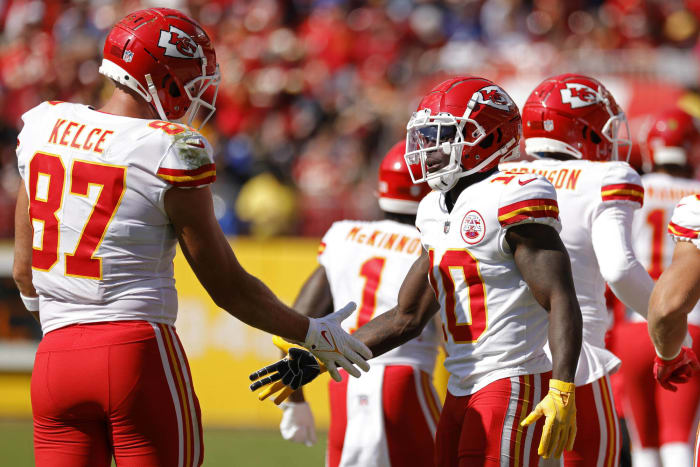
Travis Kelce and Tyreek Hill thrived separately, but the eventual Hall of Famers played together for six years. We will focus on the four with Patrick Mahomes running the show (2018-21). The Chiefs rostered the league's best tight end and its most dangerous deep threat, accelerating Mahomes' virtuoso rise. The Chiefs peaked with this duo during the first half of the 2018 season, before the team booted rushing champ Kareem Hunt once a video of him assaulting a woman in Cleveland surfaced. The Chiefs added the talented but injury-prone Sammy Watkins to this mix for a stretch, and the former top-five pick made pivotal playoff contributions en route to the team's back-to-back Super Bowl cameos.
14. Green Bay Packers: Lombardi's impact felt in early '60s

The Packer outfits that kickstarted the Super Bowl era are better known visually, but Green Bay's offense from Vince Lombardi's first string of championship games was better. Centered around fullback Jim Taylor and halfback Paul Hornung, the Pack's chain-movers of this period helped Lombardi's team repeat as champions (1961-62). The '62 team is one of the best ever, posting a plus-267 point differential in 14 games. Taylor outrushed Jim Brown, marking the only time during Brown's career he did not win the rushing crown, while ends Boyd Dowler and Max McGee had more juice compared to their Super Bowl versions. Better known for blocking, tight end Ron Kramer also ripped off four straight 500-yard seasons.
13. Houston Oilers: AFL dynasty forms
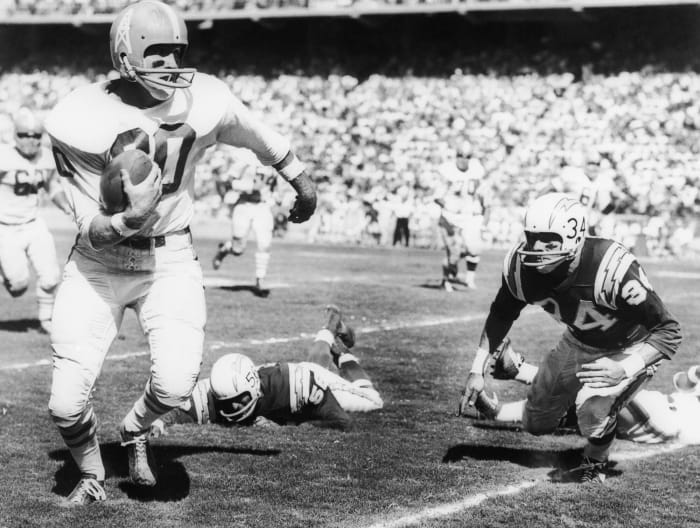
It took a double-overtime effort from the Dallas Texans to deny the Oilers a threepeat to open the AFL. Winning the 1960 and '61 AFC crowns, Houston used a pass-happy offense. Some of the records Oiler receivers set lasted for decades. Charley Hennigan's 1,746 receiving yards in 1961 remained the AFL-NFL record until Jerry Rice got there in 1995. It took 63 years for Bill Groman's rookie-year yardage mark (1,473) to fall (Puka Nacua). These two meteoric rises accompanied ex-Heisman winner Billy Cannon, who racked up 1,534 scrimmage yards in 1961. No one topped George Blanda's 36 TD passes (1961) for 23 years. Houston's square-one dynasty is probably not mentioned enough.
12. San Francisco 49ers: West Coast Offense's masterwork

One of the great blueprints in NFL history produced multiple peaks. The 1984 apex brought Bill Walsh's best, an 18-1 season without a skill-position All-Pro. The 49ers' late-'80s return to the mountaintop featured the greatest receiver ever, an elite WR2 and Walsh's backfield chess piece in high gear. San Francisco's Jerry Rice-John Taylor-Roger Craig troika helped Joe Montana cement himself as a top-tier all-time QB, with the legendary passer winning back-to-back MVPs from 1989-90 despite Walsh's retirement. Tight end Brent Jones and Pro Bowl fullback Tom Rathman rounded out the 49ers' storied arsenal; no team has come closer to threepeating in the Super Bowl era.
11. New England Patriots: Belated Brady help arrives

An understaffed receiving corps held the 2006 Patriots back; their 2007 reaction proved quite effective. Acquiring Randy Moss and Wes Welker via trade, the Pats added Donte' Stallworth in free agency. The result: Tom Brady setting the single-season touchdown pass record, moving it to 50. New England remains the only team to finish a regular season 16-0, with Moss' TD reception record (23) unchallenged since. Welker strung together five Pro Bowls as a Patriot, and tight end Ben Watson joined Kevin Faulk as ancillary options. Brady's 2008 injury, and the 2010 Moss trade made this more of a one-year firestorm, though it is tough to overstate the fear factor the '07 Pats supplied.
10. New Orleans Saints: Oozing skill depth in Louisiana

The NFL is now three years into the 17-game era, yet the 2011 Saints' total yardage record (7,474) remains. While the Saints put together a prolific 2011, their four seasons with Jimmy Graham as their starting tight end brought brilliance. Every box is checked here. Driving Drew Brees to his best season, which featured a then-record 5,476 yards, the '11 Saints deployed six 500-yard receivers. Though never a Pro Bowler, Marques Colston brought reliable WR1 work alongside walking-mismatch Graham. No 21st-century receiver's 17.9 career YPC matches Devery Henderson's, while Lance Moore was a steady chain-mover. Darren Sproles complementing Pierre Thomas, as Mark Ingram learned, rounded out a corps without weaknesses.
9. Indianapolis Colts: Future stars flank Marvin, 'Edge

Edgerrin James and Dallas Clark's best contributions did not overlap; the latter became an elite target in the late 2000s. During the earlier part of the decade, Clark observed as Indianapolis' receiver-fueled crew set or aided NFL records. Marvin Harrison's 143 catches in 2002 broke a record by 20, while the '04 Colts — the first of Peyton Manning's two seasons breaking the TD pass record — featured three 1,000-yard wideouts. James and Harrison are enshrined in Canton, while Reggie Wayne — an overqualified WR2 during Harrison's prime — is close. James left the Colts in 2006, and while Joseph Addai helped the team to a Super Bowl win, the team's best all-around work came earlier.
8. Miami Dolphins: Warfield supplements ground force

In 1970, the Dolphins traded first-round picks for their coach (Don Shula) and their No. 1 wide receiver (Paul Warfield). Both moves catalyzed an offense that became known for a dominant ground attack. Miami upgraded on Jim Kiick with Mercury Morris, who joined Larry Csonka as the NFL's first 1,000-1,000 rushing tandem in 1972. The Dolphins finished as the NFL's top rushing attack from 1971-73, journeying to three straight Super Bowls. One of the league's most graceful wideouts, Warfield kept defenses honest with his deep-game prowess. These weapons made Bob Griese's life cozy for an extended period.
7. Denver Broncos: Elway enjoys late-career spoils
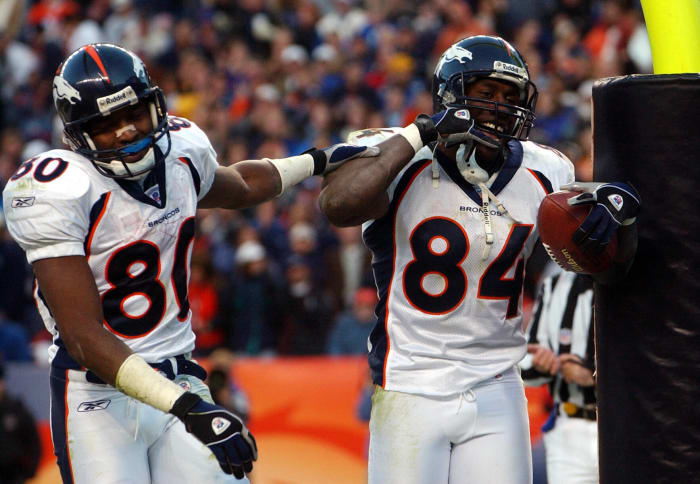
For three seasons in the late 1990s, the Broncos did not have a notable deficiency on offense. Mike Shanahan's club went 39-9 from 1996-98. Denver rolled out a skill corps consisting entirely of off-grid investments. Hall of Famers Terrell Davis and Shannon Sharpe: sixth- and seventh-round picks. Rod Smith was undrafted out of a Division II school; Ed McCaffrey was on team No. 3, having been primarily a backup as a Giant and 49er. This blend stampeded through the NFL, giving John Elway a dynamic nucleus at the end of his career. Davis and Sharpe went 6-for-6 in All-Pro nods in this span. A future Pro Bowler, Smith served as overqualified tertiary help (1,100-plus yards in '97 and '98) on the Super Bowl teams.
6. Pittsburgh Steelers: A roster-building opus

With free agency nearly 20 years away, the Steelers did not need to worry about its armada of draft hits breaking up. As a result, the Lynn Swann-John Stallworth and Franco Harris-Rocky Bleier pairs were locked in alongside Terry Bradshaw, who twice saw tight end Bennie Cunningham eclipse 500 yards during Pittsburgh's heyday. Harris and Bleier became the NFL's second 1,000-1,000 duo in 1976, and the Mel Blount Rule worked in Swann and Stallworth's favor starting in 1978. Of course, both had shown tremendous promise when DBs could still smother receivers in the mid-'70s. The Steelers' embarrassment of riches spilled over to the skill spots for many years.
5. Dallas Cowboys: Triplets drive dynasty

Michael Irvin arrived during Tom Landry's final draft in charge, but the other two "Triplets" and their supporting cast came as Jimmy Johnson rebuilt the team. Armed with extra picks in the 1990 and '91 first rounds after the Herschel Walker heist, Dallas loaded up on the skill spots by taking Emmitt Smith and Alvin Harper. Jay Novacek, a Plan B free agent in 1990, built on the Cardinals form he had shown to become a Pro Bowler in Dallas. This was the 1990s' defining skill squadron. The group's best work came with Harper, who worked as Irvin's wingman from 1992-94. In that span, Smith, Irvin and Novacek combined to go 9-for-9 in Pro Bowls while being part of a near-threepeat.
4. Baltimore Colts: Canton bastions intersect

The principals' primes do not line up, but the Colts paired three Hall of Famers — to go with the era's premier QB, Johnny Unitas — from 1963-67. Ready from the jump, John Mackey joined established stars Raymond Berry and Lenny Moore in Baltimore. The Colts finished as a top-five offense in each of these five seasons, but the cadre crested from 1964-65. At 31, Moore — a historically rare hybrid player — scored an NFL-most 19 TDs to boost a 12-2 Colts team. Unitas claimed MVP in 1965, as Berry, Mackey and fellow All-Pro wideout Jimmy Orr combined for 24 TD grabs. Mackey emerged with this trio past 30, but the overlap created a special array during the Don Shula years.
3. Minnesota Vikings: Randy Moss arrives

The Cris Carter-Jake Reed tandem yielded three top-eight offenses from 1994-97, as Robert Smith began to develop into an upper-echelon running back. Being the team to stop Randy Moss' draft slide changed the equation. Drafting the polarizing Marshall prospect at No. 21 in 1998, the Vikings zoomed to a then-record 556 points. Moss delivered the greatest rookie season in WR history and topped that yardage total in 1999 and 2000. He and Carter went 1,200-1,200 for three straight years, while Smith exploded for a 1,500-yard rushing slate in 2000 before retiring at 28. Reed's presences on the '98 and '99 teams made those the Vikes' best work samples.
2. St. Louis Rams: Greatest Show on Turf

Although Isaac Bruce was in place, the other St. Louis pillars did not surface until 1999. During draft weekend '99, the Rams acquired Marshall Faulk and chose Torry Holt in Round 1. Holt will one day follow Faulk and Bruce to Canton, and the three and low-level free agency add Kurt Warner formed the guts of the famed Greatest Show on Turf nucleus — known as the plainer Midwest Express in the moment — that thrived during a three-year span in which the NFL MVP award went Warner-Faulk-Warner. For all three seasons, the Rams ranked first in points and yardage. Even the role players — slot option/return man Az Hakim and possession cog Ricky Proehl — made memorable contributions during the zenith of St. Louis football.
1. San Diego Chargers: Air Coryell

Don Coryell's signature arsenal was so talented it lost the flashiest wideout of the era (John Jefferson) and kept going. Air Coryell 1.0 consisted of Jefferson, Kellen Winslow and Charlie Joiner. The first team to produce three 1,000-yard pass catchers, the 1980 Bolts deployed an acrobatic young star, the NFL's top receiving tight end and a possession target who retired with the career reception mark. Also here: Pro Bowl RB Chuck Muncie and future Hawaii mainstay James Brooks, who showed flashes before a trade to the Bengals. The Bolts immediately replaced Jefferson with Wes Chandler and kept going; Chandler's 1982 remains the NFL's yards-per-game standard. While San Diego's defense kept Dan Fouts' troops out of a Super Bowl, the Bolts carried the NFL's No. 1 offense each year from 1979-82.
Sam Robinson is a Kansas City, Mo.-based writer who mostly writes about the NFL. He has covered sports for nearly 10 years. Boxing, the Royals and Pandora stations featuring female rock protagonists are some of his go-tos. Occasionally interesting tweets @SRobinson25.
More must-reads:
- 10 notable steals from the 2024 NFL Draft
- Five undrafted rookie free agents who should make a 53-man NFL roster
- The 'Most career passing touchdowns' quiz
Breaking News
Customize Your Newsletter
 +
+
Get the latest news and rumors, customized to your favorite sports and teams. Emailed daily. Always free!
Use of this website (including any and all parts and
components) constitutes your acceptance of these
Terms of Service and Privacy Policy.

